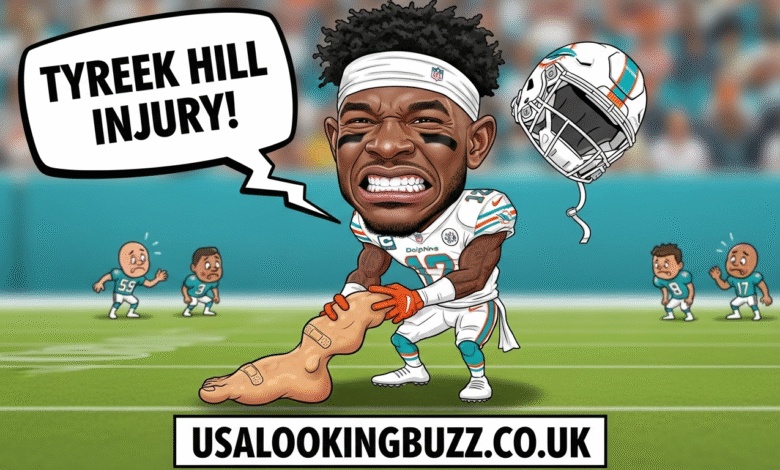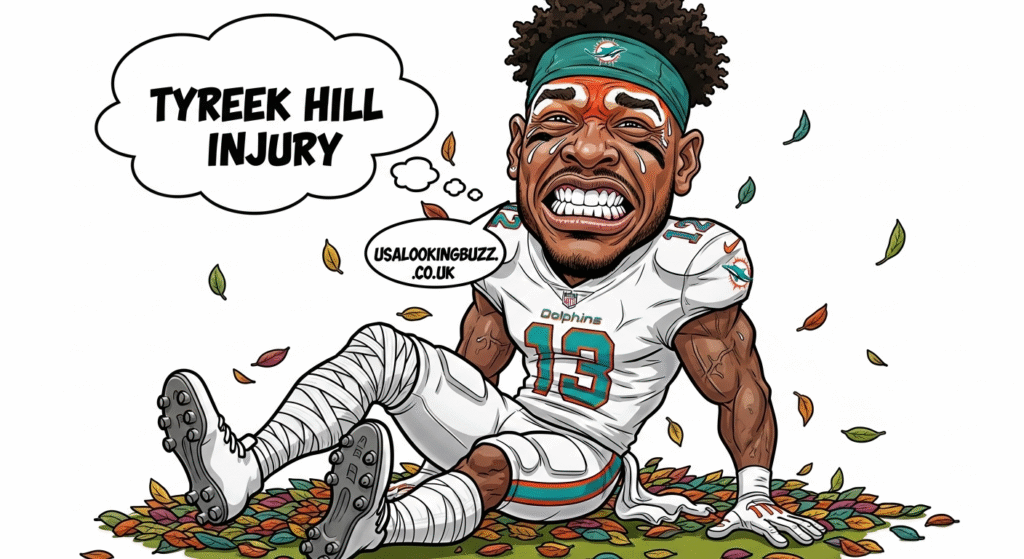Understanding Tyreek Hill Injury: Impact, Recovery, and Future Prospects

Introduction to Tyreek Hill Injury
Tyreek Hill, a prominent wide receiver in the National Football League (NFL), sustained a significant injury during the 2022 season, drawing considerable attention from fans, analysts, and medical professionals alike. The injury occurred during a crucial game against the Green Bay Packers, where Hill was forced to exit the field after a hard tackle resulted in a lower body injury. This mishap not only raised immediate concerns about Hill’s fitness but also left a substantial impact on his team, the Miami Dolphins, as well as on his overall career trajectory.
The significance of the tyreek hill injury extends beyond the game itself. Before the injury, Hill was having an outstanding season, demonstrating exceptional performance and solidifying his status as one of the top wide receivers in the league. His ability to change the dynamics of a game with his speed and agility made him an invaluable asset for the Dolphins. Therefore, the injury posed not only a personal challenge for Hill but also raised questions about how it would affect the Dolphins’ offensive strategy and playoff aspirations.
As Hill began his recovery process, discussions surrounding the severity of the injury and its potential long-term effects gained momentum. In professional sports, injuries can often lead to a decline in performance or even career-ending consequences. Consequently, the tyreek hill injury became a focal point in analyzing player fitness levels, medical care, and rehabilitation protocols within the league. The outcome of this situation may redefine Hill’s future prospects in the NFL and influence the perception of his resilience and determination as both an athlete and a competitor.
The Nature of the Injury
Tyreek Hill, a prominent figure in professional football, has faced significant challenges due to his recent injury. The specifics of the tyreek hill injury reveal a complex interplay of factors that affect both players and their performance. In Hill’s case, medical assessments indicate a soft tissue injury, particularly involving the hamstring or potentially the groin area, common in high-intensity sports where explosive movements are crucial. These types of injuries are characterized by strains or tears of the muscles, resulting in varying degrees of severity. A professional athlete can expect varying recovery times depending on the extent of the injury.
The severity of tyreek hill injury can range from mild, which may only require a few weeks of rehabilitation, to severe injuries that can sideline a player for an extended period. Knowing that professional athletes often push their bodies to the limits, a soft tissue injury demands not only proper diagnosis but also a meticulous recovery protocol. In many cases, a comprehensive treatment plan may include rest, physical therapy, and gradual reintroduction to training activities. This approach ensures that the athlete regains full strength and function before returning to competitive play.
Recovery timelines for injuries similar to the one suffered by Hill may range from 2 to 8 weeks, depending upon individual healing responses and adherence to therapeutic protocols. It is important to note that rushing back into games can lead to re-injury, which is a common concern among those in high-impact sports. Furthermore, a commitment to proper rehabilitation, preventive exercises, and strengthening can play a significant role in the future performance and longevity of an athlete’s career. Understanding the nature of tyreek hill injury provides valuable insights into the commitment required for optimal recovery and continued excellence in the sport.
Injury Impact on Performance
Tyreek Hill injury has undeniably had a significant impact on his performance as well as on the overall dynamics of the team he represents. During the period Hill has been sidelined, statistics reveal a notable decline in offensive production for the squad. Before his injury, Hill was not only a top performer but also a crucial asset in the team’s strategic play. His explosive speed and ability to stretch the field created numerous opportunities for other teammates, facilitating scoring drives and enhancing the team’s competitiveness.
Several specific games highlight the severity of Hill’s absence. For instance, during the match against the Baltimore Ravens, where he was unable to participate, the team struggled to find consistency in the passing game. Without Hill’s deep-threat capability, defenses were able to focus on minimizing the effectiveness of other receivers. This resulted in fewer points scored and a visible drop in overall offensive efficiency. Game statistics indicate that the team faced challenges in converting third downs and maintaining drives, reflecting the direct correlation between Hill’s presence and the team’s performance metrics.
Looking forward, it is essential to analyze what adjustments might be necessary for Hill’s return. Potential changes in how the offense operates could arise due to the evolving dynamics of the team. Hill must not only regain his physical form but also work to rebuild the chemistry established with his quarterback and fellow receivers. Furthermore, it will be interesting to observe whether the coaching staff integrates new strategies to leverage Hill’s unique skill set effectively, particularly in high-pressure situations. The anticipated comeback of Hill is poised to be an exciting element of the remainder of the season, and fans will be eager to see how his injury affects his performance upon return.
Comparison with Other Players
In the landscape of professional football, injuries are an unfortunate reality that players often face. Tyreek Hill injury, though alarming for fans and teammates alike, can be contextualized by examining the experiences of other NFL players who have encountered similar setbacks. Specifically, injuries classified under the broad umbrella of soft tissue or lower limb issues can severely affect a player’s agility and performance, which is critical, especially for position players like Hill, who rely predominantly on speed and quickness.
A notable example in recent history is that of Odell Beckham Jr. His recovery from a severe knee injury underwent various stages, showcasing both challenges and triumphs. Beckham’s initial struggles post-injury involved uncertainty regarding his explosiveness on the field. However, through rigorous rehabilitation and conditioning, he managed to make a successful return, albeit with some lingering concerns about his durability. This reflects the kind of journey Tyreek Hill IInjury may navigate as he focuses on his rehabilitation and regaining his peak performance despite a challenging injury backdrop.
Similarly, the case of Saquon Barkley illustrates the road to recovery from an anterior cruciate ligament (ACL) injury. After sustaining the injury, Barkley faced considerable scrutiny about whether he would return to form. Through dedicated recovery efforts and gradual reintegration into competitive play, he demonstrated that it is indeed possible to make a successful comeback. These comparative instances illustrate the realities of injury recovery in professional sports, giving hope that Tyreek Hill injury may only be a temporary obstacle in an otherwise promising career.
Overall, while every player’s journey is unique, the examples of Beckham and Barkley serve as testament to resilience and the potential for recovery, offering a glimpse into what may lie ahead for Tyreek Hill should he undertake a well-structured rehabilitation program.
Team Strategies in Response to the Injury
The Tyreek Hill Injury has undoubtedly forced the Miami Dolphins to recalibrate their strategies and tactics on the field. Hill, known for his exceptional speed and agility, has been a cornerstone of the team’s offensive capabilities. With his absence, the coaching staff has been compelled to rely on alternative strategies that leverage the strengths of other players, thereby ensuring the overall effectiveness of the team’s dynamics remains intact.

In the immediate aftermath of Hill’s injury, the Dolphins strategically shifted their game plan to incorporate a more balanced offensive approach. This entailed a greater emphasis on leveraging the depth of their receiving corps. Players such as Jaylen Waddle and Cedrick Wilson have been called upon to step into heightened roles, making critical receptions and absorbing the defensive pressure that Hill traditionally attracted. The coaching staff has focused on integrating their unique skills into game scenarios, fostering a collaborative effort to mitigate the loss of Hill’s explosive playmaking ability.
Moreover, the coaching staff has emphasized the importance of adaptability among their players. Practices have seen an increased focus on drills designed to enhance chemistry among the receivers, allowing for improvisation and quick decision-making during games. The dolphins have also adopted a more diverse offensive playbook, incorporating short to intermediate passes that play to the strengths of their line-up while minimizing risk. By doing so, the team aims to maintain their competitive edge despite the absence of Tyreek Hill.
Overall, the active engagement of the coaching staff and other players illustrates the resilience of the Dolphins as they navigate the challenge posed by Hill’s injury. Their multifaceted approach not only seeks to optimize performance in the short term but also aims to reinforce team unity and cohesion, crucial elements as they strive for success in a highly competitive league.
Rehabilitation and Recovery Process
The rehabilitation and recovery process for athletes suffering from injuries, such as Tyreek Hill injury, is a multifaceted approach that aims to restore physical functionality and psychological well-being. Upon diagnosis, a comprehensive assessment is conducted to determine the nature and severity of the injury. This informs the creation of a personalized rehabilitation strategy, often beginning with initial rest and inflammation management through ice, compression, and elevation methods.
As the healing progresses, athletes typically transition to physical therapy that focuses on regaining strength, flexibility, and range of motion. Therapy sessions may include various modalities such as manual therapy, electrical stimulation, and targeted exercises. For Tyreek Hill, this phase might involve customized drills that mirror game-specific movements, allowing him to reinforce muscle coordination without risking further injury. Such exercises are crucial as they progressively prepare the athlete for a return to competitive play.
An often overlooked aspect of recovery is the mental component. Athletes face significant psychological hurdles post-injury, including fear of re-injury and the pressure to perform at previous levels. Psychological support through counseling or sports psychology can play a vital role in addressing these concerns. Techniques such as visualization and mindfulness may help athletes like Hill manage anxiety and focus on their rehabilitation goals. Building a resilient mindset is essential for successfully navigating the challenges of a comeback.
Furthermore, ongoing communication with medical professionals and coaching staff is critical during rehabilitation. This ensures that the recovery process aligns with the athlete’s long-term health and performance objectives. When approached holistically, the rehabilitation process not only aids in physical recovery from Tyreek Hill Injury but also fosters a resilient and prepared athlete ready to return to the competitive arena.
Media Coverage and Public Reaction
The media coverage surrounding Tyreek Hill Injury has been extensive and multifaceted, reflecting the player’s prominence in the National Football League (NFL). Following the announcement of his injury, various news outlets quickly moved to analyze the implications for both Hill and the Kansas City Chiefs. Sports analysts emphasized the potential impact of the injury on the team’s performance, particularly given Hill’s integral role as a wide receiver and playmaker. Discussions often included expert opinions on recovery protocols as well as predictions regarding Hill’s future in the league.
Public reaction has mirrored the media’s intensity. Fans expressed a mix of concern and cautious optimism on social media platforms, with many sharing their sentiments regarding Hill’s resilience and potential for a comeback. Speculation regarding whether Hill would return to peak form has also fueled numerous discussions among fans. The narratives have ranged from predicting a swift comeback to expressing fear that the injury could hinder his career progression. In numerous online forums, fans and analysts alike highlighted Hill’s previous performance and athleticism, noting that such qualities could aid his recovery.
Moreover, the media narratives have investigated how Tyreek Hill Injury may affect his contractual situation, including potential negotiations with the Chiefs and the broader implications for his market value as an elite wide receiver. This speculation has undoubtedly added to the public’s curiosity about whether Hill would maintain his status as a top player upon his return. As time progresses, the atmosphere around Hill’s injury remains charged with interest, revealing a keen awareness from fans and observers alike. In conclusion, the combination of in-depth media analysis and passionate fan engagement shapes the ongoing discourse surrounding Tyreek Hill Injury and his prospects moving forward.
Future Prospects for Tyreek Hill
The career trajectory of Tyreek Hill following his recent injury raises significant questions about his future in the NFL. Hill, known for his explosive playmaking ability and speed, has been an essential asset to his team’s offensive strategy. The impact of the injury not only affects his immediate playing opportunities but also raises concerns about his long-term performance and overall legacy in professional football.
Recovery time is a critical factor in Hill’s return. Depending on the severity of his injury, medical professionals typically provide a rehabilitation plan that may range from several weeks to a few months. In Hill’s case, the expectation is that with diligent rehabilitation, he could potentially return to the field in the early part of the upcoming season. The commitment to a comprehensive recovery protocol is vital for regaining peak physical condition, which Hill must prioritize to reclaim his position as one of the elite players in the league.
Preparedness for a comeback will dominate discussions about Hill’s return. His ability to adapt his training regimen to ensure that he not only returns but also matches or exceeds his prior levels of performance will be pivotal. As a player renowned for his speed and agility, any impact on these attributes due to injury recovery needs to be closely monitored. Hill’s determination and work ethic will play a crucial role in his comeback journey, as he seeks to minimize any lingering effects from the injury.
Finally, it is essential to contemplate how this injury could influence Tyreek Hill’s legacy within the NFL. A successful return could solidify his status as one of football’s most resilient athletes, showcasing his capability to overcome adversity. However, a decline in performance could prompt discussions about the long-term implications of injuries on speed-oriented players, which might affect how his career is ultimately remembered. Regardless of the outcome, the coming months will be critical in determining Hill’s future in the sport.
Conclusion
Tyreek Hill Injury has been a pivotal moment in both his career and the Kansas City Chiefs’ season. As one of the league’s most explosive wide receivers, his ability to stretch the field not only impacts his personal performance but also the overall dynamics of the team’s offense. The injury, which raised concerns among fans and analysts alike, has forced the coaching staff to adapt and explore alternative strategies. The importance of Hill to the Chiefs cannot be understated; his speed and skill set elevate the entire team’s performance. Losing a player of his caliber invariably affects game plans and can alter the trajectory of the team’s postseason aspirations.
Although Hill’s injury has undoubtedly posed challenges, the outlook for his recovery is promising. Advances in sports medicine and rehabilitation practices offer athletes like Hill a solid framework for recovery. Notably, his determination and previous experience with returning from injuries will play a significant role in this journey. The Chiefs’ medical staff is likely to implement a tailored recovery program to ensure that he regains full strength, minimizing the risk of reinjury. Hill’s return to form will not only restore a vital offensive weapon for the Chiefs but will also send a positive message to players dealing with similar injuries throughout the league.
In the broader context of the NFL, Hill’s injury serves as a reminder of the inherent risks in professional football, emphasizing the need for teams to cultivate depth within their rosters. As Tyreek Hill embarks on his recovery journey, both his teammates and the Chiefs’ fan base remain hopeful for a swift return to the field. His resilience and talent are expected to shine through as he aims to reclaim his position among the elite in the league, maintaining his status as a key figure in the future of the NFL.




